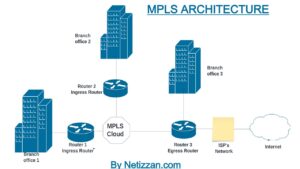In today’s age of modern networking, efficient packet routing stands as the cornerstone of achieving a secure network and delivering high-speed internet connections. In the pursuit of optimal data transmission, various packet forwarding algorithms have emerged, each striving to enhance network performance and reliability. Among these, Multiprotocol Label Switching (MPLS) has emerged as a frontrunner, gaining widespread adoption.
In this article, we will delve into Multiprotocol Label Switching, covering its intricate workings, advantages, and status as a driving force behind the revolution in modern networking.
Also, We will explore how MPLS combines the best of both circuit-switched and packet-switched networks, providing a superior framework for the transmission of data across networks.
What is MPLS?
MPLS is traffic routing technology that uses Layer 2.5 of the OSI model to enhance efficient forwarding of data packets using labels. MPLS leverages the power of both layer 2 packet switching and Layer packet routing technology.
When a data packet is sent to a network that has MPLS implemented on it, the packet undergoes the following process;
- Label Assignment: When a data packet enters an MPLS-enabled network, the first router (ingress router) assigns a label to the packet. This label is a short identifier that represents the path or route the packet should take through the network.
- Label Pushing: The first router replaces the traditional destination IP address in the packet’s header with the assigned label. The label is then used to make forwarding decisions instead of the original IP address. This process is called “label pushing.”
- Label Switching: The packet, now carrying the label, is forwarded through the MPLS network from one router to the next. At each intermediate router, the forwarding decision is made based on the label. Routers maintain a forwarding table that maps incoming labels to the appropriate outgoing interface.
- Label Popping: When the labeled packet reaches the last router before the destination (egress router), the label is removed from the packet. This process is known as “label popping.” The egress router examines the original destination IP address, which has been preserved within the packet, and forwards it to the appropriate outbound interface based on standard IP routing.
- IP Routing: After the label is removed, the egress router employs standard IP routing to determine the best path for the packet to reach its final destination.
Here is an MPLS network architecture of a Wide area network.

We have a separate post where we explained this MPLS network architecture of a WAN. We encourage you to go though it for deeper understanding.
Types of MPLS
There are 3 types of MPLs each with its own functionalities; viz
- MPLS Layer 2 (MPLS L2): This type of MPLS operates at the data link layer (Layer 2) of the OSI model. It uses labels to make forwarding decisions based on MAC addresses, making it suitable for connecting multiple sites within a local area network (LAN).
- MPLS Layer 3 (MPLS L3): MPLS Layer 3 operates at the network layer (Layer 3) of the OSI model. It assigns labels to packets based on IP addresses, making it ideal for routing traffic between different networks across a wide area network (WAN).
- MPLS Layer 2 Virtual Private Networks (MPLS L2 VPNs): MPLS L2 VPNs provide point-to-point or point-to-multipoint connections between sites, creating a virtual LAN-like environment over an MPLS network. This type of MPLS is commonly used to connect remote offices or to provide secure connectivity between different parts of an organization’s network.
Benefits of Using MPLS in a Network
- Faster Packet Forwarding: MPLS allows for faster forwarding of data packets because the forwarding decision is based on labels, which are much simpler and quicker to process than full IP headers.
- Traffic Engineering: MPLS enables network administrators to set up explicit paths for traffic through the network, improving traffic engineering and Quality of Service (QoS) capabilities.
- Virtual Private Networks (VPNs): MPLS can be used to create virtual private networks, allowing multiple customers or sites to share the same underlying infrastructure while keeping their traffic isolated and secure.
- Scalability: MPLS is highly scalable, making it suitable for large networks with complex traffic patterns.
- High-Speed Internet Access: MPLS optimizes data transmission paths, reducing the time taken for routing decisions. This leads to faster internet access, benefiting users with quicker response times and improved overall network performance.
- Improved Quality of Service (QoS): MPLS allows network administrators to prioritize specific types of traffic, ensuring critical applications receive the necessary bandwidth and QoS. This feature ensures a smooth and consistent user experience, especially for time-sensitive applications like voice and video.
- Enhanced Network Security: MPLS inherently enhances network security through its label-switching mechanism. By segregating and isolating data packets with labels, MPLS reduces the risk of unauthorized access and prevents data leaks.
- Streamlined Network Management: MPLS simplifies network management by reducing the complexity of routing decisions. The pre-established paths based on labels reduce the need for complex route lookups at each hop, leading to easier network administration.
- Cost-Effective Solution: MPLS can help businesses optimize their network infrastructure, leading to cost savings in the long run. Its ability to consolidate data traffic and prioritize critical applications results in a more efficient use of bandwidth and resources.
- Support for Cloud Computing and Data Centers: MPLS facilitates seamless connectivity and data transfer in cloud computing and data center environments. It supports the growth of these technologies by providing a reliable and efficient network foundation.
Application of MPLS in Modern Network
Multiprotocol Label Switching (MPLS) has transitioned from a theoretical concept to a practical and widely adopted technology in the networking world. Here are some application of MPLS in modern network;
A. Real-World
MPLS has found its footing in a multitude of real-world applications, enhancing data transmission and communication in various industries.
In finance, MPLS is used to ensure secure and seamless financial transactions, enabling businesses to process large volumes of sensitive data with speed and precision.
In the healthcare sector, MPLS facilitates the secure transfer of patient records and medical imaging, supporting timely diagnoses and treatment decisions.
Educational institutions benefit from MPLS in building efficient networks to support online learning and collaboration among students and faculty.
B. Enterprise Networks
Enterprises across the globe are integrating MPLS into their Wide Area networks to meet the demands of a digitally connected workforce. MPLS enables organizations to prioritize critical applications, like customer relationship management (CRM) systems and video conferencing tools
Additionally, MPLS-based VPNs provide secure connections between different offices and remote workers, allowing businesses to share sensitive data without compromising confidentiality.
C. ISPs Networks
Service providers rely on MPLS to deliver efficient and reliable network services to their customers. MPLS allows them to create virtual private networks that cater to individual client needs
For Internet service providers, MPLS streamlines traffic management and enables dynamic rerouting. It ensures optimal data flow and minimizing downtime. This level of control and flexibility is important for providing top-notch services to customers with diverse requirements.
D. Cloud Computing
In this era of cloud computing and data centers, MPLS enhance data transfer between various cloud-based services and data storage facilities. MPLS ensures efficient data flow by reducing latency and enhancing user experiences with cloud-based applications.
For businesses that heavily rely on cloud services, MPLS provides a reliable and scalable network foundation, supporting the growing demands of cloud computing.
Conclusion
Multiprotocol Label Switching (MPLS) has proven to be a revolutionary packet switching protocol that operates at a unique level in the OSI model, often referred to as layer 2.5. MPLS optimizes data transmission by replacing the IP address in the IP header, which is a layer 3 information, with a label at the first router. This label-switching mechanism enables the packet to traverse through the network at layer 2, significantly improving data forwarding efficiency.
As the packet reaches its destination, the label is removed, and the packet is “popped” back to layer 3, exposing the original IP address of the intended destination. This seamless transition between layer 2 and layer 3 is what distinguishes MPLS as a layer 2.5 protocol in the OSI model.

I am a passionate Networking Associate specializing in Telecommunications.
With a degree in Electronic engineering, I possess a strong understanding of electronic systems and the intricacies of telecommunications networks. I gained practical experience and valuable insights working for a prominent telecommunications company.
Additionally, I hold certifications in networking, which have solidified my expertise in network architecture, protocols, and optimization.
Through my writing skills, I aim to provide accurate and valuable knowledge in the networking field.
Connect with me on social media using the links below for more insights.
You can contact me using [email protected] or connect with me using any of the social media account linked below



